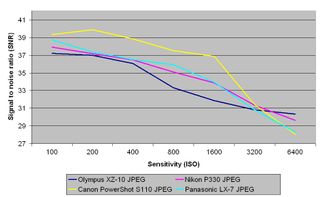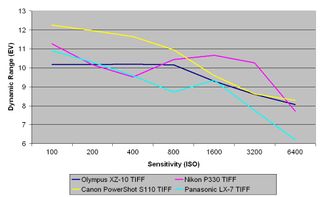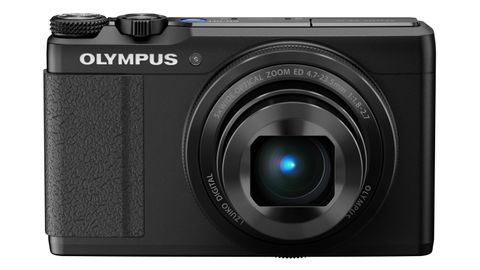Why you can trust TechRadar
We shoot a specially designed chart in carefully controlled conditions and the resulting images are analysed using DXO Analyzer software to generate the data to produce the graphs below.
A high signal to noise ratio (SNR) indicates a cleaner and better quality image.
For more more details on how to interpret our test data, check out our full explanation of our noise and dynamic range tests.
Here we compare the Olympus XZ-10 with the Canon PowerShot S110, Nikon Coolpix P330 and Panasonic LX7.
JPEG signal to noise ratio

These results show that JPEG images from the Olympus XZ-10 contain a weaker signal to noise ratio than JPEGs from the Canon PowerShot S110, Nikon Coolpix P330 and Panasonic LX7 at low-to-mid sensitivities, though at ISO 3200 the Olympus's JPEGs draw level with the Panasonic's, and at ISO 6400 the Olympus's JPEGs come out slightly ahead of all the other cameras'.
Raw signal to noise ratio

The signal to noise ratios of the TIFF images (after conversion from raw) from the Olympus XZ-10 are stronger than its JPEGs, coming out ahead of the Panasonic LX7's at every sensitivity except ISO 100, and beating the Nikon Coolpix P330 at ISO 100-400, and again at ISO 6400. Between ISO 800 and 3200, however, the Olympus's TIFF images have weaker signal to noise ratios than the Nikon's. The Canon PowerShot S110's TIFFs beat the Olympus's at every sensitivity indicating that it produces cleaner images.
JPEG dynamic range

The Olympus XZ-10's JPEGs show relatively strong dynamic range at low-to-mid sensitivities, coming out ahead of the Canon PowerShot S110 and Nikon Coolpix P330's JPEGs at ISO 100-400, while sitting just below the Panasonic LX7's JPEGs at ISO 100-200, before overtaking at ISO 400. At ISO 800-3200 the Olympus's JPEGs display weaker dynamic range than the Canon and Panasonic's, before coming out on top again at ISO 6400. The Olympus's JPEGs beat the Nikon's at every sensitivity.
Raw dynamic range

This chart indicates that TIFF images (after conversion from raw) from the Olympus XZ-10 show a smaller and weaker dynamic range than those from the Canon PowerShot S110, at every sensitivity. The Olympus's TIFFs show greater dynamic range than the Nikon Coolpix P330's at ISO 400 and 6400, and the same sort of amount at ISO 200, but are weaker at other sensitivities. The Olympus's TIFFs show greater dynamic range than the Panasonic LX7's at every sensitivity but ISO 100 - although at ISO 200 and 1600 the two cameras produce very similar results.
Current page: Noise and dynamic range
Prev Page Image quality and resolution Next Page Sample imagesAmy has been writing about cameras, photography and associated tech since 2009. Amy was once part of the photography testing team for Future Publishing working across TechRadar, Digital Camera, PhotoPlus, N Photo and Photography Week. For her photography, she has won awards and has been exhibited. She often partakes in unusual projects - including one intense year where she used a different camera every single day. Amy is currently the Features Editor at Amateur Photographer magazine, and in her increasingly little spare time works across a number of high-profile publications including Wired, Stuff, Digital Camera World, Expert Reviews, and just a little off-tangent, PetsRadar.

This has to be the most absurd portable power station ever launched — Asus's Mjolnir throws the hammer at rivals with innovative design that's likely to divide opinions

Pixel's new satellite feature could show people where you are on Google Maps

I really hope Google doesn't promise 7 years of Android for the Pixel 8a

